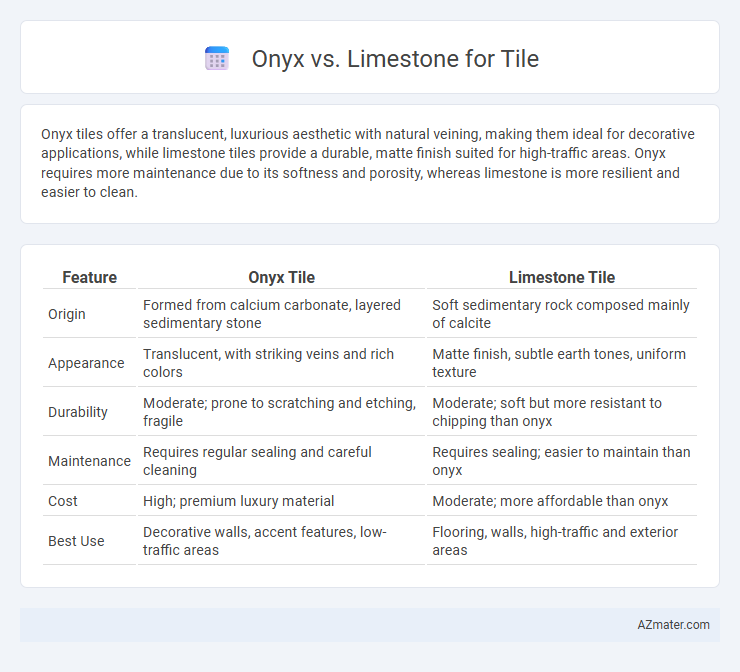Onyx tiles offer a translucent, luxurious aesthetic with natural veining, making them ideal for decorative applications, while limestone tiles provide a durable, matte finish suited for high-traffic areas. Onyx requires more maintenance due to its softness and porosity, whereas limestone is more resilient and easier to clean.
Table of Comparison
| Feature | Onyx Tile | Limestone Tile |
|---|---|---|
| Origin | Formed from calcium carbonate, layered sedimentary stone | Soft sedimentary rock composed mainly of calcite |
| Appearance | Translucent, with striking veins and rich colors | Matte finish, subtle earth tones, uniform texture |
| Durability | Moderate; prone to scratching and etching, fragile | Moderate; soft but more resistant to chipping than onyx |
| Maintenance | Requires regular sealing and careful cleaning | Requires sealing; easier to maintain than onyx |
| Cost | High; premium luxury material | Moderate; more affordable than onyx |
| Best Use | Decorative walls, accent features, low-traffic areas | Flooring, walls, high-traffic and exterior areas |
Overview of Onyx and Limestone Tiles
Onyx tiles are prized for their translucent beauty, rich veining, and luxurious appearance, often used in feature walls and backsplashes to create dramatic visual impact. Limestone tiles offer a more subdued, matte finish with a natural, earthy texture and are favored for flooring and outdoor applications due to their durability and slip resistance. Both materials require proper sealing to protect against stains, with onyx demanding more delicate maintenance because of its softer, more porous structure.
Key Differences Between Onyx and Limestone
Onyx features a translucent, vibrant appearance with unique veining patterns, making it a luxurious choice for decorative tiles, while limestone offers a more subdued, matte finish with a uniform texture suited for rustic or traditional designs. Onyx is softer and more prone to scratching and etching compared to the denser, more durable limestone, requiring careful maintenance and sealing. Limestone's porous nature makes it more absorbent but also easier to repair than onyx, which demands specialized care to preserve its clarity and shine.
Durability and Strength Comparison
Onyx tiles exhibit a unique translucent quality but are significantly softer and more prone to scratching and etching compared to limestone, making them less durable for high-traffic areas. Limestone offers greater strength and resistance to wear, with a density that withstands heavy foot traffic and reduces chipping risk. When prioritizing durability and strength, limestone is generally the superior choice for tile applications in both residential and commercial environments.
Aesthetic Appeal: Onyx vs Limestone
Onyx tiles showcase a striking translucency with vibrant color patterns, creating a luxurious and dramatic visual impact ideal for feature walls and accent pieces. Limestone tiles offer a more subtle, earthy aesthetic with muted tones and natural textures that blend seamlessly into rustic or traditional design schemes. The choice between onyx and limestone hinges on whether a space demands bold elegance or understated natural beauty.
Installation Requirements and Challenges
Onyx tiles require professional installation due to their softness and translucency, making them more prone to cracking and chipping compared to limestone, which is denser and more durable. Onyx demands specialized adhesives and careful handling to prevent damage during cutting and setting, whereas limestone's installation is more forgiving with standard tiling materials. Both materials need proper sealing, but onyx's higher porosity makes it more susceptible to staining, requiring more frequent maintenance post-installation.
Maintenance and Cleaning Needs
Onyx tiles require gentle cleaning with pH-neutral products to prevent etching and preserve their natural translucency, making maintenance more delicate compared to limestone. Limestone tiles are more porous and susceptible to staining, necessitating regular sealing and the use of mild, non-acidic cleaners to maintain their appearance. Both materials need routine care, but onyx demands more careful handling to avoid damage, while limestone requires consistent sealing to protect against moisture and dirt.
Cost Analysis: Onyx vs Limestone Tiles
Onyx tiles typically cost between $20 and $40 per square foot, making them significantly more expensive than limestone tiles, which range from $5 to $15 per square foot. The higher price of onyx is due to its translucent quality and rarity, while limestone's affordability stems from its abundant availability and easier quarrying process. Maintenance costs also differ, as onyx requires more frequent sealing and care, potentially increasing overall expenses compared to the more durable limestone.
Suitability for Different Spaces
Onyx tiles offer a luxurious, translucent appearance ideal for low-traffic areas such as bathrooms, accent walls, and decorative surfaces due to their softness and susceptibility to scratching. Limestone tiles provide durable, textured surfaces suitable for high-traffic spaces like kitchens, hallways, and outdoor patios, offering slip resistance and resilience under heavy use. Selecting onyx or limestone depends on balancing aesthetic appeal with functional demands of the specific environment.
Environmental Impact and Sustainability
Onyx tiles, composed primarily of calcite, require significant energy-intensive quarrying and processing, contributing to higher carbon emissions compared to limestone. Limestone, being more abundant and softer, allows for less invasive extraction methods, resulting in a reduced environmental footprint and better sustainability profile. Choosing limestone tiles supports eco-friendlier construction practices due to their lower embodied energy and greater potential for recycling and reuse in sustainable building projects.
Which Tile is Right for Your Project?
Onyx tiles offer stunning translucency and vibrant color variations, making them ideal for decorative applications that showcase natural light, while limestone tiles provide a more subdued, matte finish with excellent durability suited for high-traffic areas. Consider onyx for projects prioritizing aesthetic impact and a luxurious appearance, especially in bathrooms or feature walls, whereas limestone is preferred for flooring and outdoor spaces due to its slip resistance and weather tolerance. Your choice depends on balancing visual appeal with functional needs, ensuring the tile aligns with the environment and usage intensity of your project.

Infographic: Onyx vs Limestone for Tile
 azmater.com
azmater.com